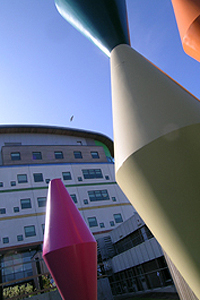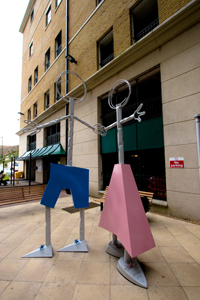Public realm art works can be brought about in many different ways. They can be commissioned by local government agencies, councils, hospitals, schools etc… funded by various different bodies which can either be brought about by the funders, competitions or funded by individuals or groups. The can be spontaneous acts by individuals/community groups/activists. Can range from functional, commemorative or decorative works. I wanted to look at some different examples of art in the public realm which scope these different approaches.
Local
I had heard a few things about the cross monument recently built at Saltash and had heard mixed feelings about the monument so felt this might be a good one to look into for a local work.
The Saltash Waterfront Residents Association, according to the Saltash Cornish Cross website, looked at regenerating Elwell Woods and decided it would be a good place for a monument at the gate way to Cornwall. A site unused since 1961, it involved the whole community and people volunteered to clear the site and make it a usable space for people, wildlife and plants too. Old variety apple trees were planted as the ruins of an old cider house were found there.
The artist, Simon Thomas, was approached and funding was secured to build the Cross and bring it to Saltash. The inspiring monument has been, fabricated from materials representing the county’s engineering heritage as well as its ambitions for a new technological future , It will become an enduring icon for a forward looking and spirited Cornwall, proud of its past and open to what is to come.
So in this case the `artist was approached by the commissioning body to create the work. It cost £656.000 to build, the figures are listed on their website here http://www.saltashcornishcross.co.uk/facts-and-figures.html as to divided costs of materials, labour and how much Thomas received is not listed. I have searched for some public opinion on the monument and here are a few examples…
I have read in the Saltash Observer that the long awaited plastic abomination of a Cornish Celtic Cross is going to be in place later this year : I wonder if the people involved in this so called Celtic Cross know just what the Celtic Cross represents, I doubt it , any true Cornish person would have thrown it out, makes me wonder if any of the decision makers are Cornish
why is it that the gateway to Cornwall has to have this plastic imitation and not a true CORNISH GRANITE CROSS ?
I thought it was going to be steel plated with copper, rather than plastic?! And at 62 foot tall, that would be an enormous weight of granite! It’s a modern interpretation – times change.I thought it was going to be steel plated with copper, rather than plastic?! And at 62 foot tall, that would be an enormous weight of granite! It’s a modern interpretation -times change.
I think with most public art works feelings will be divided. Thomas as an artist works with modern materials and mathematical processes. I can see how he has tried to combine traditional narrative details, like the dry stone wall effect and copper with materials and processes suitable for the scale of the commission. As to my own opinion, I’m not sure whether I like it or not, I’m a bit in different. It does grab me but neither does it repulse me. I think the site as a whole in regenerating an area of disuse has more appeal to me and have personally walked around the area which is a lovely, tranquil place to be and feels safe even at night. Works like this are not just about the ‘thing’ but how they sit in the environment and how it affects those using that environment. Over all, despite some negative feelings towards the monument I think this was a good way to combine commemoration in a site specific place which is enjoyed daily by those around it. Saltash is quiet a run down area and has a lot of drug problems and social deprivation which needed a project to inspire people and give them somewhere beautiful which they can be proud of.
Hospital
 The Royal Alexandra Children’s Hospital in Brighton have several works outside the building. These works are designed to make children coming into the hospital that it is a welcoming place and not to be scared of. ‘Buoys’ (pictured left) created by Ally Wallace are a series of brightly coloured aluminium columns that look like huge toy blocks, they are placed randomly outside of the new building, as if they are bobbing about on the sea.
The Royal Alexandra Children’s Hospital in Brighton have several works outside the building. These works are designed to make children coming into the hospital that it is a welcoming place and not to be scared of. ‘Buoys’ (pictured left) created by Ally Wallace are a series of brightly coloured aluminium columns that look like huge toy blocks, they are placed randomly outside of the new building, as if they are bobbing about on the sea.
‘Boy and Girl’ by Jon Mills is a painted steel sculpture. The boy and girl stand together, holding hands, as friends or brother and sister, welcoming everyone into the children’s hospital.
The latest addition to the outside artworks is ‘Crumpleslide’ by Walter Jack, installed in 2009 it is made of a foam core with a smooth fibreglass finish, it is a bumpy slide that is the shape of a crumpled up piece of paper. The only image I could find is above but through my search on Walter Jack it lead me to this page here…
http://www.architecturetoday.co.uk/?p=20390
Located in Redruth, Cornwall, Heartlands is a £35m development aimed at transforming 7.5 hectares of former tin mining land into cultural, community and commercial facilities for local residents and tourists. Currently under construction, Crushed Wall by Walter Jack Studio is a 25-metre-long by three-metre-high concrete retaining wall leading from the village of Pool to the main Heartlands site.
‘Crushed Wall is for me about two things’, says Walter Jack. ‘It is about place and process. Heartlands is geologically very special. Nineteenth-century miners dug an astonishing 1000 metres down through granite to extract tin ore. This is one of the hidden stories Heartlands will celebrate. When the studio was asked to design a retaining wall, the geological connection seemed serendipitous. Retaining walls hold back the geology; they are the boundary between the above-ground world and the world of mining’.
One of the things that interests Jack as a maker is the way that manufactured things are often duller than the processes that bring them into being. ‘Concrete for example, is not usually noted for its fluid softness, although its starts out as a liquid. We wanted our concrete to tell its own story, to retain the ‘liquidness’ of its process’. (text taken from site) I like the way he is using a material which has the expectation of being dull and which is normally used in a certain way in a completely different way. This could be something to take into my own project work.
The starting point for the detail design was a length of rubber sheet, some plywood and a hired cement mixer in Jack’s back garden. The final shutter was built in one piece using a single sheet of rubber that measured 40 metres long by four metres high and weighed a tonne. At the lower end of the wall, the rubber sheet is crumpled down to a height of 1.5metres. At its highest point the sheet hangs like a curtain.
Once the shape was formed the shutter was carefully cut into six pieces. One of the challenges was to retain continuity of the fluid form between the shutters. After some successful prototyping, the shutters were delivered to Ladds Concrete, which is close to the site. Weighing up to 20 tonnes each, the precast sections of wall were delivered to site and installed with millimetre accuracy. Located between each panel is an 18mm expansion joint, filled with foam core insulation and faced externally with a concrete coloured structural silicone sealant.
Project team
Designer: Walter Jack Studio; design team: Walter Jack, Paul Channing, Rowan Mackay; structural engineer: Structural Solutions; concrete consultant: David Bennett; surveyor: Dando Surveying, landscape architect: Cornwall Council; client: Heartlands.
Selected suppliers and subcontractors
Concrete, reinforcement: Ladds Concrete; concrete shutters: Richard Stump, John Hall.
(text taken from site)
I love the process of this design and it’s links with the cultural heritage of the site. Also how, if we look at things differently to the normal ie: a wall being a smooth or stacked surface structure to separate one mass from another space and how this can be defined into something unique.
Graffiti Craft in the public realm
I want to feature the work of French artist Madame Maurice who creates hundreds of small origami creations which she then groups together in bright, eye-catching colours around dull walls and pavements in Paris
I think this shot here is clever placement by her as it involves one of the biggest and most prolific public art/architectural structures in the world. It is a prime location to be photographed anyway and by placing her work here it is bound to be noticed.
2013, August, Mademoiselle Maurice has been invited by the general hospital in Singapore to realise a wall of 30 meters. The Singhealth service contact me to give a positive message about gift of blood/organs or other. Months before, people of the hospital, doctor, patient, children and schools of Singapore fold 1.000.000 of origamis flowers! The message of this operation was: “gift of life , gift of hope”. I chose to put this words on the wall and to create something like an ECG line. In my work, the thousands of folding are at the image of thousands of people in a common action, in this situation, this image makes senses, and give a beautiful feeling of sharing and solidarity.
These kinds of works are temporary, not all public art is permanent and can be exhibited for a certain amount of time before they are taken down or in some cases degrade. I like how she has connected the geometric folds with that of an ECG line and the engagement of the people using and working in the hospital to join together to create the work. Making people a part of the art connects it with the people around it, creates good feeling towards it and engages people in the making process which can help with confidence, mood, motor skills, brain function and also bonding with people around you.
Site Specific Pubic Art
I watch this TED talk by Janet Echelman who through a happy accident ended up using the traditional craft of knotting fishing nets with combined modern technological materials and engineering to create huge sculptures which are some now permanent fixtures in public spaces across the world. By looking and discovering what was around her, she began to look at ordinary things in a new way and has created something amazing. In the video she tells you about how long this process actually tool, years to develop the material choices, technology to create patterns and the structures with which to support them. All without really having any back ground in this field. She was a painter and through a trip to exhibit her work in India, she arrive but her paints did not. She stumbled on the fishermen on the shores when she went walking to try to figure out something to make and started from here, creating small scale work, but realised in order to push them beyond objects you look at, which have a beauty they would need to be scaled up. It is a really good example of going out of your comfort zone, looking at things differently, trying new things, exploring your environment and also how combining traditional with modernity can provide surprising results.






